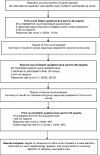Towards a definition of refractory neuropathic pain for epidemiological research. An international Delphi survey of experts
- PMID: 22640002
- PMCID: PMC3476440
- DOI: 10.1186/1471-2377-12-29
Towards a definition of refractory neuropathic pain for epidemiological research. An international Delphi survey of experts
Abstract
Background: Best current estimates of neuropathic pain (NeuP) prevalence come from studies using various screening detecting pain with probable neuropathic features; the proportion experiencing significant, long-term NeuP, and the proportion not responding to standard treatment are unknown. These "refractory" cases are the most clinically important to detect, being the most severe, requiring specialist treatment.
Methods: We report an international Delphi survey of experts in NeuP, aiming for consensus on the features required to define, for epidemiological research: (1) neuropathic pain; and (2) when NeuP is "refractory". A web-based questionnaire was developed and data collected from three rounds of questionnaires from nineteen experts.
Results: There was good consensus on essential inclusion of six items to identify NeuP ("prickling, tingling, pins & needles", "pain evoked by light touch", "electric shocks or shooting pain", "hot or burning" pain, "brush allodynia on self-examination", and "relevant history") and on some items that were non-essential. Consensus was also reached on components of a "refractory NeuP" definition: minimum duration (one year); number of trials of drugs of known effectiveness (four); adequate duration of these trials (three months / maximum tolerated); outcomes of treatment (pain severity, quality of life). Further work needs to validate these proposed criteria in general population research.
Conclusions: This paper presents an international consensus on measuring the epidemiology of refractory neuropathic pain. This will be valuable in reaching an agreed estimate of the prevalence of neuropathic pain, and the first estimate of refractory neuropathic pain prevalence.
Figures



References
-
- Bennett GJ. In: Molecular Biology of Pain. Borsook D, editor. IASP Press, Seattle, WA; 1997. Neuropathic pain: an overview; pp. 109–113.
-
- Bowsher D, Rigge M, Sopp L. Prevalence of chronic pain in the British population: a telephone survey of 1037 households. The Pain Clinic. 1991;4:223–230.
Publication types
MeSH terms
Grants and funding
LinkOut - more resources
Full Text Sources
Other Literature Sources

